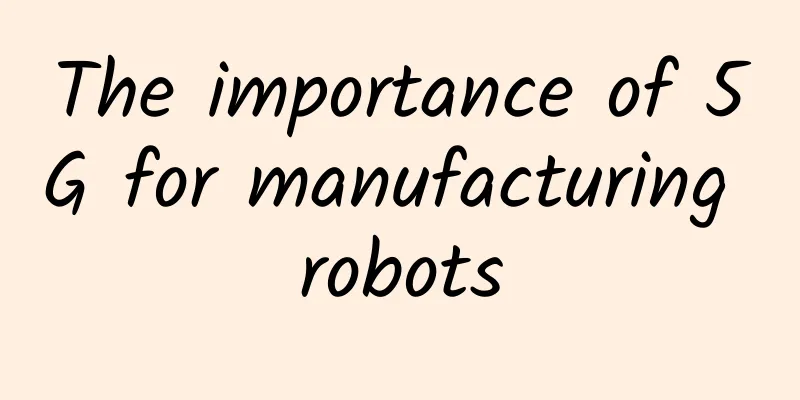The importance of 5G for manufacturing robots

|
The use of robots is often associated with the pursuit of efficiency and productivity. According to the International Trade Administration, across all industries, every 1% increase in robot density leads to a 0.8% increase in productivity. Today, robotics in manufacturing is the highlight of this ongoing story, with robots now present at every stage of the manufacturing process across all industries. While the use of robotics in manufacturing is not new, the adoption of these technologies has exploded in recent years. In the early days of robotics, it was primarily large manufacturers such as automakers that used mobile robotic arms for tasks such as welding and painting. However, a rapidly changing business environment has led to a significant increase in the adoption of robotics in manufacturing by businesses of all sizes. The versatility and efficiency of robots are now a core component of modern manufacturing operations, enabling companies to remain competitive and adapt to the changing demands of the market. The growing availability of private 5G networks can enhance manufacturers’ ability to manage robots and implement processes such as digital twins, predictive maintenance, and advanced analytics. Understanding the field of manufacturing robotsSeveral factors have contributed to the popularity of robots in the manufacturing industry. As the technology matures, the cost of robots continues to fall. It is expected that by 2025, the cost of industrial robots will drop by half, making it easier and more economical for more companies to use robots. At the same time, according to Deloitte's 2023 Manufacturing Outlook, manufacturers continue to deal with supply chain disruptions, skilled labor shortages, and cost pressures. Robotics can help minimize the impact of these challenges while improving business resilience. Robots in manufacturing are now more capable, flexible, and smarter, making it easier to find, adapt, and integrate robotics to transform operations and build the smart factory of the future. By leveraging wireless connectivity, mobile edge computing, and artificial intelligence (AI), robots can move materials throughout factory production lines, assemble and weld products, package products for sale, and transport products from warehouse shelves to pallets and trucks. Use cases of robotics and automation in manufacturingRobotics has several exciting use cases in manufacturing that are only beginning to be applied on the factory floor. For example, 3D printing technology allows manufacturers to efficiently produce complex parts, assemblies, and products using robots. By producing products on demand rather than in large batches, manufacturers can significantly reduce warehousing costs while producing products to the exact specifications of customers, allowing for greater design flexibility without the associated setup and production costs. Other manufacturing areas that are well suited for robotics include tasks that require a high degree of autonomy and intelligence to enable complex decision-making or problem-solving, such as maintenance and repair. By combining predictive analytics with robotics, the system can identify potential maintenance issues and then automatically trigger the robot to perform the repair, all without human intervention. Robotics can also significantly improve worker health and safety. Manufacturing robots can take on dangerous tasks, helping to reduce the risk of accidents or injuries. It also reduces the need for personnel to perform repetitive tasks, allowing people to focus on more complex and interesting work. Promoting the development of manufacturing robotics technologyAs robots become cheaper and more ubiquitous in manufacturing, they are making their way from large factories to the smallest manufacturing plants. But to fully leverage the use of robots in manufacturing, companies must also invest in other technologies, including: Sensors and control systemsThese basic components enable the robot to navigate and interact with its surroundings by sensing obstacles and other objects. Using cameras, LiDAR sensors that create a 3D map of the environment, force sensors that detect contact, and other sensors that detect sound and infrared radiation, the robot's control system can synthesize information and decide how to interact in the environment to complete tasks safely and efficiently. Internet of Things (IoT)By connecting, monitoring and managing operations in near real time, manufacturers can gain deeper insight into their processes and optimize the use of robots. By exchanging information with other systems and equipment (such as other robots, sensors and control systems), factories can achieve just-in-time manufacturing processes, ensuring seamless coordination of the entire manufacturing chain. Artificial Intelligence and Machine LearningBy learning from experience, robots can adapt to perform tasks more efficiently, without being limited by their initial programming. Edge computingThe more digitalized the manufacturing process becomes, the more data is generated. Edge computing technology enables robots to access and analyze large amounts of data to help improve processes and enable predictive maintenance. Advanced analytics enabled by edge computing enable manufacturers to analyze operational data and identify trends so they can make data-driven decisions to optimize the use of robots. The importance of 5G for manufacturing robotsOf all the technologies manufacturers need to know about, 5G is one of the most important. 5G has the potential to support the massive data demands of robotics, IoT, and the cloud that might otherwise limit the full potential of manufacturing robotics. 5G networks can provide faster speeds and lower latency than previous generations of mobile technology and can help manufacturers improve the way they control and monitor robots. This will not only help manufacturers better manage individual robots and their overall robot fleets, but also allow them to monitor performance in near real time, allowing them to instantly incorporate process improvements. In addition, 5G networks can enable near real-time communication between robots, sensors, control systems, and cloud platforms. By improving the ability to exchange data and information between robots, connected devices, and other data sources, manufacturers can enable robots to adapt and learn while helping human operators make more informed decisions about their work. 5G networks can also enable manufacturers to connect factories with other parts of the supply chain, warehouses, logistics and transportation partners, retailers and even customers. 5G and IoT can allow all stakeholders to easily and quickly exchange data to coordinate production, inventory, shipping and sales, reducing delays while improving forecast accuracy and product delivery times. 5G helps connect factories of the futureFinally, 5G networks can help manufacturers leverage other advanced technologies to maximize the performance of robots, such as: Augmented and virtual realityAugmented reality overlays digital information onto the real world so employees can view and interact with virtual objects in their physical surroundings, while virtual reality creates fully immersive digital environments. Both technologies can be used for training, visualizing complex processes, and collaborating with remote team members. Digital TwinVirtual representations of physical assets can be used to simulate their performance, allowing manufacturers to identify issues, optimize processes, and perform testing without taking the physical robot offline. Predictive MaintenanceThe use of sensors, data analytics, and machine learning can help manufacturers better predict when robotic equipment is likely to fail so they can schedule required maintenance in advance to help prevent and reduce any unexpected downtime. Advanced AnalyticsBy using data to identify patterns across the business, manufacturers can optimize processes, identify opportunities for improvement, and improve forecasting. |
<<: Understand 5G-A multi-frequency coordination—“3CC” in one minute
>>: What is bandwidth management?
Recommend
If the server does not receive the fourth wave request during the four TCP wave requests, will the server keep waiting?
I'm going to copy an answer from a certain we...
Come and watch! The Maker Beijing 2020 Kunpeng Application Innovation Special Competition Seminar is about to start!
In order to help more ICT industry practitioners ...
The Legend of Network Protocols (IV): Be Careful in the Evolutionary Path
Vinton Cerf, who is revered as the "Father o...
As the gateway integrator, this open source web application hosting tool is a magical tool!!!
introduce Today I would like to introduce an inte...
How to set up a backup internet connection for your home office
For work from home, one factor that businesses mu...
Interviewer: What are the underlying data types of Redis? Why is Redis so fast? Why did Redis introduce multithreading? What is the implementation mechanism of Redis multithreading?
Interview question overview: What are the underly...
With the advent of the 5G era, will the divorce rate drop?
01 The divorce rate remains high during the epide...
Introduction to Virtual Switch Technology and Practical Applications in IP Metropolitan Area Networks
With the continuous development of information te...
Five things you need to know about the current state of 5G
5G is a rare combination of national will and mar...
Huawei's F5G optical access partners in China have exceeded 900, and the "1+3+5" prairie fire action has been upgraded
From March 14th to 15th, the "Huawei China P...
Operational data of the three major operators in May: 5G has a unique outlook
Now in the motherland, more than 10,000 5G base s...
In the 5G era, what is the way out for the three major operators that are crying poor?
As 2017 was coming to an end, news about 5G becam...
RackNerd: Multi-data center VPS annual payment starts at $10, place an order to win a random blind box and get a discount
RackNerd has launched the 2022 Black Friday promo...
How blockchain can change the way SMEs conduct business
As the application of blockchain technology incre...
![[11.11]RAKsmart: US servers start from $30/month, Japan/Korea servers start from $59/month, cluster servers start from $109/month](/upload/images/67cabd1fbfac6.webp)








